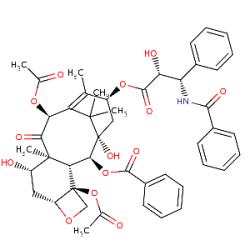Molecular Playground/Taxol
From Proteopedia
(New page: Paclitaxel (Taxol) A CBI Molecule being studied in the [http://www.umass.edu/cbi/ University of Massachusetts Amherst Chemistry-Biology Interface Program] a...) |
|||
| Line 3: | Line 3: | ||
A [[CBI Molecule]] being studied in the [http://www.umass.edu/cbi/ University of Massachusetts Amherst Chemistry-Biology Interface Program] at UMass Amherst and on display at the [http://www.molecularplayground.org/ Molecular Playground]. | A [[CBI Molecule]] being studied in the [http://www.umass.edu/cbi/ University of Massachusetts Amherst Chemistry-Biology Interface Program] at UMass Amherst and on display at the [http://www.molecularplayground.org/ Molecular Playground]. | ||
| - | Paclitaxel, also called as Taxol, is a plant derived anticancer drug. It was first isolated from the bark of Pacific yew tree, ''Taxus brevifolia''. It has been FDA approved for the treatment of ovarian, breast and non-small cell lung cancer. Taxol binds to the ends of microtubules and inhibits further microtubule elongation. This prevents the cell from dividing and causes the cell to die. Because cancer cells divide much quicker than normal cells, taxol predominantly attacks tumors. | + | Paclitaxel, also called as Taxol, is a plant derived anticancer drug. It was first isolated from the bark of Pacific yew tree, ''Taxus brevifolia''.Paclitaxel is a complex diterpenoid product, with a bulky, fused ring system as well as a number of hydrophobic substituents. It has been FDA approved for the treatment of ovarian, breast and non-small cell lung cancer. Taxol binds to the ends of microtubules and inhibits further microtubule elongation. This prevents the cell from dividing and causes the cell to die. Because cancer cells divide much quicker than normal cells, taxol predominantly attacks tumors. |
Presently, taxol supply is made available either through a semi-synthetic route using precursors isolated from needles of yew species or through ''Taxus'' cell suspension cultures. ''Taxus'' cell suspension culture is an alternative to stripping bark from ''Taxus'' trees and extracting precursors from needles. | Presently, taxol supply is made available either through a semi-synthetic route using precursors isolated from needles of yew species or through ''Taxus'' cell suspension cultures. ''Taxus'' cell suspension culture is an alternative to stripping bark from ''Taxus'' trees and extracting precursors from needles. | ||
| Line 15: | Line 15: | ||
<applet size='[450,338]' frame='true' align='right' | <applet size='[450,338]' frame='true' align='right' | ||
| - | caption='Paclitaxel (Taxol)' /> | + | caption='Paclitaxel (also known as Taxol)' /> <scene name='Rohan_Patil/Sandbox1/Taxol/6'>Paclitaxel</scene> |
| - | + | Molecular Playground Banner: "Paclitaxel (Taxol), a natural product with anti-cancer activity" | |
Revision as of 21:20, 29 April 2010
A CBI Molecule being studied in the University of Massachusetts Amherst Chemistry-Biology Interface Program at UMass Amherst and on display at the Molecular Playground.
Paclitaxel, also called as Taxol, is a plant derived anticancer drug. It was first isolated from the bark of Pacific yew tree, Taxus brevifolia.Paclitaxel is a complex diterpenoid product, with a bulky, fused ring system as well as a number of hydrophobic substituents. It has been FDA approved for the treatment of ovarian, breast and non-small cell lung cancer. Taxol binds to the ends of microtubules and inhibits further microtubule elongation. This prevents the cell from dividing and causes the cell to die. Because cancer cells divide much quicker than normal cells, taxol predominantly attacks tumors.
Presently, taxol supply is made available either through a semi-synthetic route using precursors isolated from needles of yew species or through Taxus cell suspension cultures. Taxus cell suspension culture is an alternative to stripping bark from Taxus trees and extracting precursors from needles.
|
Molecular Playground Banner: "Paclitaxel (Taxol), a natural product with anti-cancer activity"
Proteopedia Page Contributors and Editors (what is this?)
Sarah Wilson, Alexander Berchansky, Rohan Patil, Elizabeth Cummings, Michal Harel, Lynmarie K Thompson

